6 Garden Ideas for a Mediterranean Feel
Just as the Mediterranean sun brings warmth and life to coastal gardens, you’ll find that creating your own slice of Mediterranean paradise isn’t as challenging as you might think. You can transform your outdoor space into a vibrant retreat with aromatic herbs, sun-loving plants, and natural materials that capture the essence of seaside living. From the gentle trickle of terra cotta fountains to the sweet scent of lavender drifting across stone pathways, each element plays a vital role in bringing this timeless style to life.
Contents
Mediterranean Plants and Color Palettes
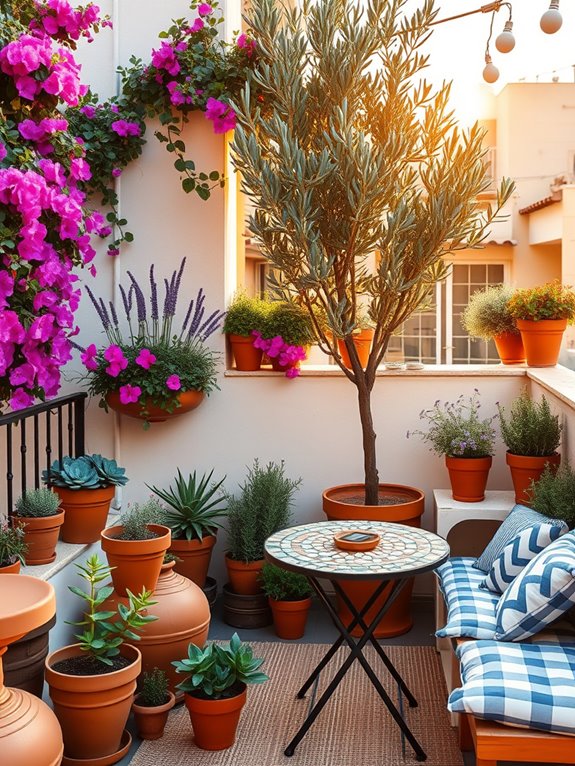
Transport yourself to the sun-drenched coasts of Greece and Italy with a garden that captures the essence of Mediterranean living. Lavender waves gently in the breeze, while cypress trees stand tall against azure skies.
Olive trees cast dappled shadows across terracotta pots filled with cascading geraniums, their vibrant reds and pinks contrasting beautifully with the silvery-green foliage of sage and artemisia. The color palette draws from nature’s warmth – sandy beiges, terra cotta oranges, and deep sea blues, complemented by the muted greens of drought-resistant plants.
This garden style embraces a rustic elegance, where climbing bougainvillea creates dramatic purple-pink canopies and rosemary releases its aromatic oils in the warm air. Mediterranean gardens celebrate texture through varying leaf shapes and sizes, from the spiky leaves of agave to the delicate fronds of palm trees.
The overall effect is one of casual sophistication, where plants grow with natural abundance while maintaining a sense of order and purpose.
Key Elements:
- Drought-resistant plants (lavender, rosemary, sage, thyme)
- Citrus trees in terracotta pots
- Olive trees
- Cypress trees
- Climbing vines (bougainvillea, jasmine)
- Ornamental grasses
- Terra cotta planters
- Gravel or pebble pathways
- Mediterranean color palette (terracotta, azure, sage green)
- Aromatic herbs
- Succulents and agaves
Begin implementation by establishing a strong structural framework with larger specimens like olive or cypress trees positioned as focal points. Layer drought-resistant plants in groups, placing taller varieties at the back and shorter ones in front.
Create defined areas using gravel pathways and terracotta pots, arranging herbs and succulents in clusters for visual impact. Incorporate climbing plants near walls or pergolas to add vertical interest and shade.
When designing a Mediterranean garden space, consider your local climate and make adjustments accordingly. For balcony gardens, focus on container plantings using terracotta pots of varying sizes, and select dwarf varieties of traditional Mediterranean plants.
Ensure proper drainage in all planters and use water-retaining soil additives to maintain moisture levels in hot conditions. Group plants with similar water needs together to optimize irrigation and maintenance routines.
Stone Pathways and Rustic Walls
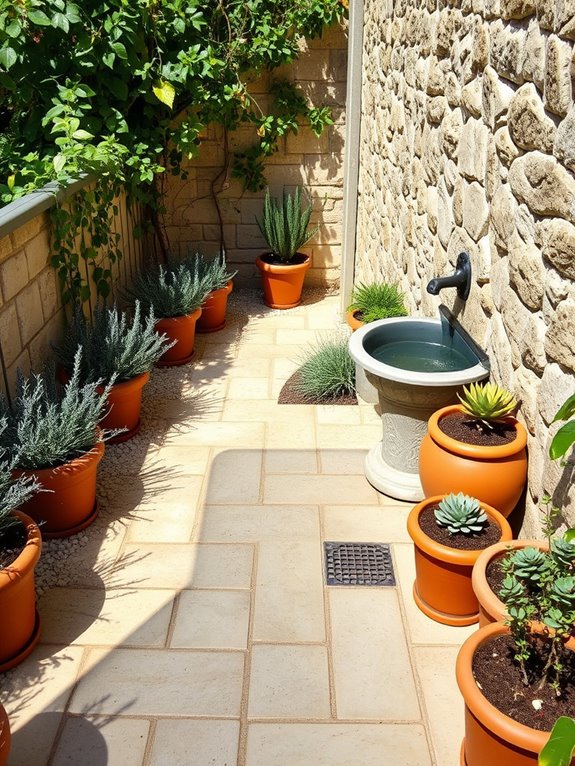
Winding stone pathways meander through sun-drenched gardens, their weathered surfaces telling tales of ancient Mediterranean villages. Natural limestone and sandstone pavers, arranged in casual patterns, create an authentic rustic charm while complementing the surrounding drought-resistant plants.
Fragrant herbs like thyme and oregano peek through the cracks between stones, softening harsh edges and adding bursts of aromatic greenery.
Rough-hewn stone walls, reminiscent of traditional Mediterranean agricultural terraces, add vertical interest and define distinct garden spaces. These walls, whether low boundary markers or dramatic retaining structures, provide the perfect backdrop for cascading rosemary and trailing lantana.
The interplay of textures between smooth and rough stone surfaces creates visual intrigue while providing essential structure to the garden design.
Key Elements:
- Natural stone pavers (limestone, sandstone, or travertine)
- Rustic stone walls or wall facades
- Drought-resistant ground covers
- Mediterranean herbs
- Gravel or pebble infill
- Weathered terracotta pots
- Wall-climbing vines
- Natural stone steps
- Aged stone features (fountains, benches)
Begin implementation by establishing the main pathway routes, ensuring they flow naturally through the space while accommodating practical movement patterns.
Layer the foundation with compacted gravel, then arrange stones in an informal pattern, leaving irregular gaps for plants. When building walls, use local stone materials when possible, incorporating slightly different sizes for authenticity.
Allow spaces between stones for small plantings, and ensure proper drainage behind retaining walls.
Extra Design Tips: Consider your climate zone when selecting stones, as some materials weather differently in various conditions.
For smaller spaces or balconies, create the illusion of stone pathways using interlocking pavers or large format tiles, and incorporate vertical stone veneer panels for walls.
Use container gardens with mixed heights to break up stark wall surfaces, and incorporate lighting to highlight stone textures after dark. Always ensure proper weight distribution when adding stone elements to elevated spaces.
Terracotta Pots and Clay Features
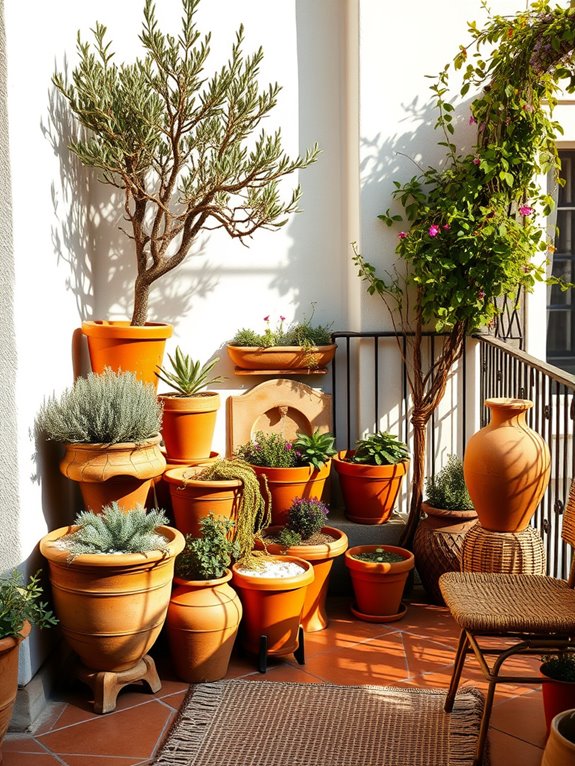
Weathered terracotta pots and rustic clay features create an instant portal to sun-drenched Mediterranean landscapes, bringing warmth and timeless charm to any garden space. The natural orange-red hues of terracotta containers, arranged in varying heights and sizes, create a harmonious display that perfectly complements Mediterranean plants like lavender, rosemary, and olive trees.
These earthen vessels develop a beautiful patina over time, adding character and authenticity to the garden while providing excellent drainage for heat-loving plants.
Clay water features, from simple fountains to ornate urns, introduce the soothing sound of trickling water while maintaining the Mediterranean aesthetic. Terracotta wall plaques, decorative tiles, and clay amphoras placed strategically throughout the space serve as focal points and conversation pieces.
The porous nature of clay materials helps regulate soil temperature and moisture, creating ideal growing conditions for Mediterranean flora while contributing to the overall rustic ambiance.
Key Elements:
- Various sized terracotta pots (from small herb containers to large statement pieces)
- Clay water features or fountains
- Decorative wall plaques and tiles
- Mediterranean plant selection
- Amphoras and urns
- Clay pot feet or risers
- Drainage materials
- Weather-resistant sealant
- Decorative pebbles or gravel
- Plant supports and stakes
When implementing a terracotta-themed garden, start by selecting a mix of pot sizes, ensuring proper drainage holes and using pot feet to prevent water damage.
Arrange larger containers as anchor pieces in corners or as focal points, then layer smaller pots around them in groups of three or five for visual interest. Seal outdoor terracotta with a weather-resistant product to extend its lifespan, and incorporate a layer of gravel at the bottom of each pot for improved drainage.
For long-term maintenance, regularly check for cracks or damage, especially after frost. Clean pots annually with a gentle brush and mild soap solution to prevent algae buildup while preserving the natural aging process.
Position water features where they can be easily accessed for maintenance, and ensure electrical connections are properly protected from the elements.
For smaller spaces or balconies, consider wall-mounted terracotta planters or hanging pots to maximize vertical space. Mediterranean herbs grow well in smaller containers, making them perfect for compact areas.
Use lightweight terracotta alternatives for upper floors, and ensure your structure can support the weight of filled pots. Group containers near building walls where they can benefit from reflected heat, and install drip irrigation systems to maintain consistent moisture levels without daily watering.
Al Fresco Dining Spaces
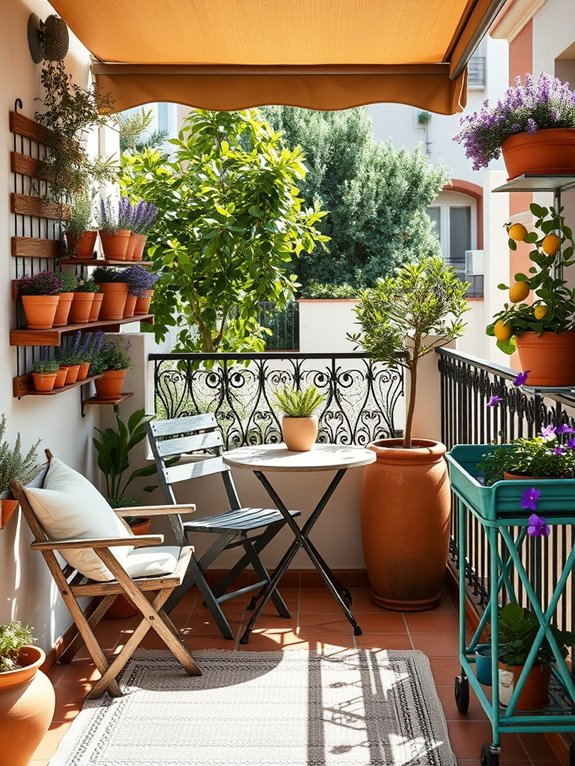
Transform your outdoor space into a charming Mediterranean al fresco dining area where sun-drenched meals and leisurely conversations become daily rituals. Picture a rustic wooden table nestled under a grape-covered pergola, surrounded by terracotta pots overflowing with fragrant herbs like rosemary, thyme, and lavender.
The natural interplay of dappled sunlight through climbing vines creates an enchanting ambiance that captures the essence of casual European dining. Weathered stone pavers underfoot complement whitewashed walls, while strategically placed olive trees provide gentle shade and Mediterranean authenticity.
String lights draped overhead twinkle as evening falls, transforming the space into an intimate dining sanctuary. Potted citrus trees and cyprus plants frame the dining area, their fresh scents mingling with herbs to create an intoxicating sensory experience.
Key Elements:
- Wooden pergola or arbor
- Rustic dining table and chairs
- Terracotta planters
- Climbing vines (grape, jasmine, or bougainvillea)
- Mediterranean herbs
- Olive or citrus trees
- Stone or terracotta pavers
- String lights or lanterns
- Outdoor serving station or sideboard
- Weather-resistant cushions and textiles
Begin implementation by establishing the foundational hardscaping with pavers or a level patio surface. Install the pergola as your central architectural element, ensuring it’s properly anchored and oriented to provide optimal shade during peak dining hours.
Position your dining furniture beneath, allowing adequate space for comfortable seating and service circulation. Create layers of greenery by installing climbing plants at pergola bases and positioning larger potted specimens strategically around the perimeter.
Integrate your herb garden within arm’s reach of the dining area, using varying heights of terracotta pots to create visual interest. Consider installing a simple irrigation system to maintain consistent moisture levels, particularly for thirsty Mediterranean plants.
Weather-proof your space by selecting durable materials and incorporating proper drainage solutions beneath pavers.
For smaller spaces or balconies, focus on vertical elements and scaled-down versions of key features. Use wall-mounted planters for herbs, consider a folding table for flexibility, and opt for dwarf varieties of Mediterranean plants.
Maximize limited square footage by incorporating built-in bench seating with storage underneath, and use mirror elements to create the illusion of a larger space while reflecting light and greenery.
Water Features and Fountains
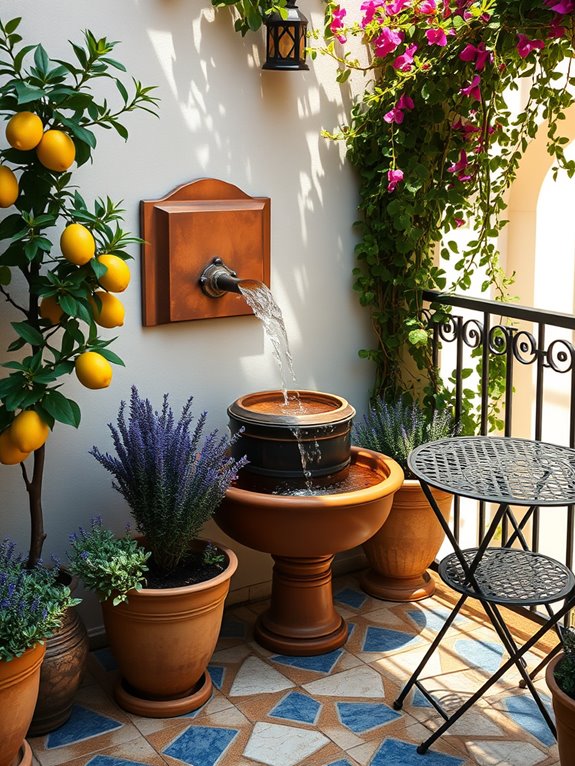
The gentle murmur of cascading water sets the perfect backdrop for a Mediterranean garden, where traditional terracotta fountains and weathered stone water features transport visitors to sun-drenched Italian courtyards. Multi-tiered fountains become natural focal points, their water dancing in the sunlight while providing a cooling effect that attracts both birds and butterflies.
Weathered copper spouts and classical statuary add authenticity, while strategically placed underwater lights create magical evening ambiance.
Stone basins filled with water lilies and surrounded by potted citrus trees capture the essence of Mediterranean garden design, where water serves both aesthetic and practical purposes. The combination of moving and still water features creates layers of sensory experience, from the energetic splash of wall fountains to the serene reflection pools bordered by lavender and rosemary.
These water elements not only provide visual interest but also help maintain humidity levels beneficial to Mediterranean plants.
Key Elements:
- Tiered stone or terracotta fountains
- Wall-mounted water spouts
- Reflection pools or basins
- Copper or bronze water features
- Traditional statuary
- Underwater lighting
- Natural stone edging
- Water-loving Mediterranean plants
- Ceramic water bowls
- Mosaic tile accents
When implementing water features, begin by selecting a focal point location visible from main viewing areas. Install larger fountains on stable, level surfaces with proper electrical and plumbing connections hidden beneath pavers or gravel.
Create depth by positioning smaller water features at varying heights, using wall-mounted options to maximize space. Ensure all water features include recirculating pumps to conserve water and maintain proper flow.
For maintenance and longevity, install an automatic fill system to maintain consistent water levels, and use algae-prevention treatments suitable for fountains containing plants or visiting wildlife.
Consider installing drip irrigation systems around water features to support surrounding Mediterranean plants while preventing water waste.
Small space adaptation tips: Wall fountains work exceptionally well in confined areas, while tabletop fountains provide Mediterranean charm for balconies.
Consider self-contained water features for spaces without plumbing access, and use lightweight materials like glass fiber reinforced concrete instead of traditional stone for upper-story installations.
Group smaller water features with Mediterranean herbs and compact citrus trees in containers to create a cohesive design that can be easily modified as needed.
Mediterranean-Style Garden Furniture and Accents
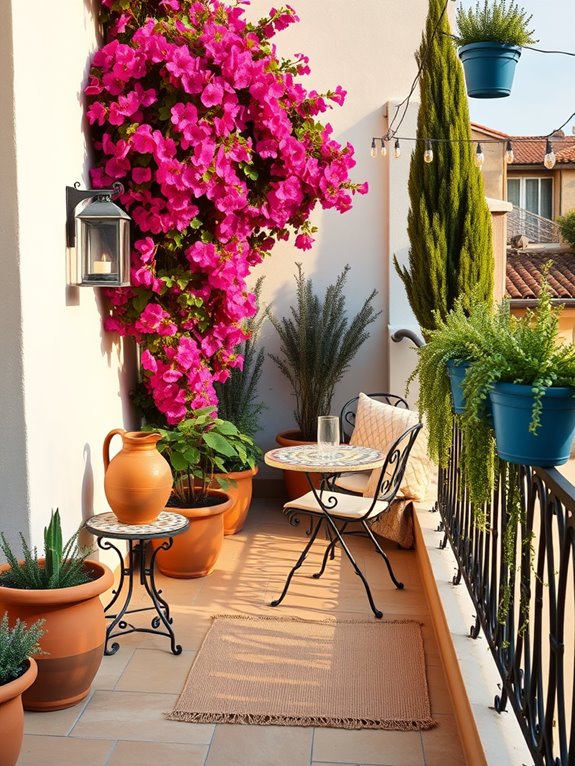
Transport yourself to the sun-drenched courtyards of Greece and Italy with carefully chosen Mediterranean-style furniture and decorative elements. Terra cotta pots, wrought iron seating, and weathered stone features create an authentic coastal European ambiance, while natural materials like wood and wicker add warmth and texture. The furniture palette typically stays neutral with creams, whites, and earth tones, allowing the vibrant plants and blue accents to take center stage.
The key to Mediterranean garden furniture lies in creating intimate seating areas that encourage outdoor living and dining. Picture mosaic-topped tables surrounded by comfortable chairs with weather-resistant cushions in muted blues and creams. Stone benches nestled among lavender and rosemary provide quiet spots for contemplation, while decorative urns and classical statuary add architectural interest and old-world charm.
Essential Elements:
- Wrought iron dining sets and bistro furniture
- Terra cotta planters and urns
- Stone or mosaic-topped tables
- Weather-resistant cushions in Mediterranean colors
- Garden benches
- Classical statuary or fountains
- Decorative tiles or mosaics
- Pottery water features
- Outdoor lighting (lanterns, string lights)
- Natural fiber rugs or mats
Arrange furniture to create distinct zones for dining, lounging, and quiet reflection. Position larger pieces like dining sets against walls or pergolas to define spaces and provide shelter from sun and wind. Integrate potted plants and climbing vines around seating areas to soften hard edges and create natural screens.
Layer lighting at different heights using wall-mounted fixtures, free-standing lanterns, and subtle uplighting to extend outdoor living into the evening hours.
When designing a Mediterranean garden space, consider your climate and exposure to elements. Choose materials that can withstand local weather conditions and treat wooden furniture with appropriate sealants.
For smaller spaces or balconies, opt for folding bistro sets and vertical planting solutions. Maximize limited square footage by selecting multi-functional pieces like storage benches or nesting tables, and use wall-mounted planters to free up floor space while maintaining the Mediterranean aesthetic.
